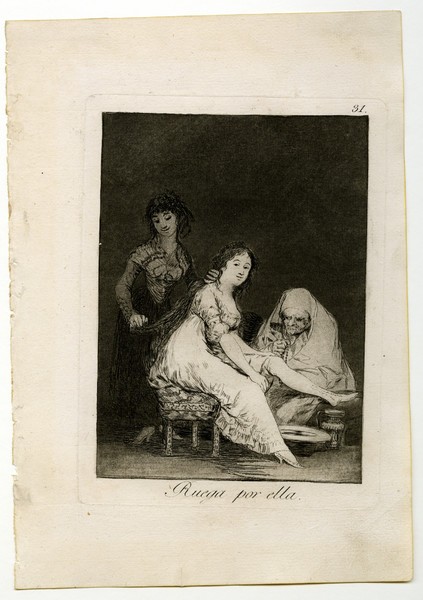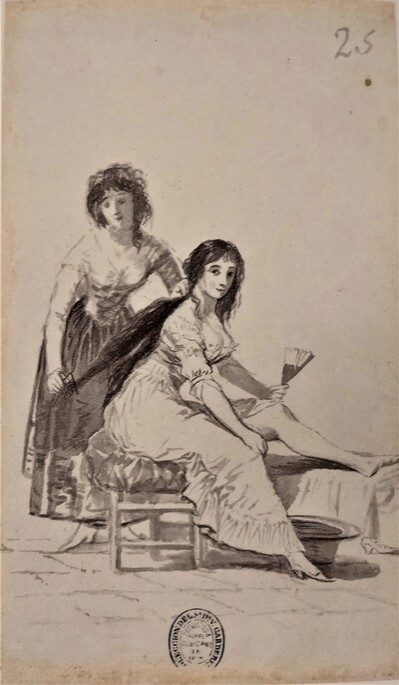- Cronología
- Ca. 1797 - 1799
- Dimensiones
- 219 x 152 mm
- Técnica y soporte
- Aguafuerte, aguatinta bruñida, punta seca y buril
- Reconocimiento de la autoría de Goya
- Undisputed work
- Ficha: realización/revisión
- 09 Dec 2010 / 29 May 2024
- Inventario
- 225
Pray for her (at the bottom).
31. (in the upper right-hand corner)
See Francisco Goya y Lucientes, Painter.
In the first state proof before the additional etching, it is clear how Goya has used the two tones of aquatint. He has also left significant reserves of varnish for the white parts such as the face, trunk and leg of the young woman. He also used a few small touches of pen ink on the girl's face.
In another proof from a state prior to the handwriting, the title is handwritten. It shows how Goya dispensed with the aquatint that obscured part of the prostitute and the old woman, and reduced it considerably in the basin and the jug. Another aquatint was added, partly burnished, which gives a soft tone to the face and left hand of the girl with the comb, as well as to the face, neck, chest and raised leg of the protagonist.
In the final version, Goya used the burin to reinforce the lines of the etching in some areas, as well as the drypoint on the harlot's chest and petticoat.
Two preparatory drawings for this engraving have survived(1) and(2).
In the centre of the engraving is a young woman seated on a low stool. Behind her a maid combs her hair and an old woman seated facing the viewer holds a rosary in her hands. The young woman lifts one of her legs to put on or perhaps take off her stocking, while looking straight ahead with a pleased gesture. She has washed herself or is about to do so, as can be seen from the basin of water and the jug that Goya has placed between the young woman in the foreground and the old woman in the background.
The painter has created two focal points in the engraving, the young woman dressed in light clothes and with the clear, clean complexion of her youth, and the old woman in the background, also dressed in light clothes. The rest remain in semi-darkness and we are unable to distinguish where the scene is taking place as there are no spatial references.
The manuscripts that explain the engravings in the series of The Caprices agree on the meaning of the print we are dealing with here. The most synthetic and clearest of them all is the one in the National Library, which reads as follows: "while the whores dress and dress themselves, the procuresses pray that God will give them great fortune, and teach them certain lessons".
It is clear that Goya is once again tackling the theme of prostitution, which he will refer to repeatedly in the engravings in this series. He depicts the intimate atmosphere in which the prostitute prepares for her work under the watchful eye of her procuress. Furthermore, the nature of this relationship in which the old woman is the guardian of her protégée is also very much in evidence.
The plate is in poor condition, with the drypoint missing and the aquatint very weakened ( National Chalcography, no. 202).
-
Goya. Gemälde Zeichnungen. Graphik. TapisserienKunsthalle BaselBasle1953from January 23th to April 12th 1953cat. 221
-
De grafiek van GoyaRijksmuseum RijksprentenkabinetAmsterdam1970from November 13th 1970 to January 17th 1971cat. 29
-
Goya. La década de Los CaprichosMadrid1992organized by Real Academia de Bellas Artes de San Fernando sponsored by Fundación Central Hispano, Madrid, consultant editor Nigel Glendinnig. From October 26th 1992 to January 10th 1993cat. 85
-
Francisco de GoyaMuseo d'Arte ModernaLugano1996exhibition celebrated from September 22nd to November 17th.cat. 31, p.58
-
Ydioma universal: Goya en la Biblioteca NacionalBiblioteca NacionalMadrid1996from September 19th to December 15th 1996cat. 118
-
Francisco Goya. Sein leben im spiegel der graphik. Fuendetodos 1746-1828 Bordeaux. 1746-1996Galerie KornfeldBern1996from November 21st 1996 to January 1997cat. 37
-
Das Capriccio als KunstprinzipWallraf-Richartz-Museum,1996from December 8th 1996 to February 16th 1997, exhibited also in Zurich, Kunsthaus, from March 14th marzo 1997 to June 1st 1997 and in Vienna, Kunsthistorisches Museum mi Palais Harrach, from June 29th 1997 to September 21st 1997.p.76, fig. 20
-
Goya artista de su tiempo y Goya artista únicoThe National Museum of Western ArtTokyo1999from December 1st to July 3th 1999cat. 111
-
Goya's RealismStatens Museum for KunstCopenhagen2000from February 11th to May 7th 2000cat. 28
-
Francisco Goya. Capricci, follie e disastri della guerraSan Donato Milanese2000Opere grafiche della Fondazione Antonio Mazzottap.28, cat. 31
-
Goya e la tradizione italianaFondazione Magnani RoccaMamiano di Traversetolo (Parma)2006consultant editors Fred Licht and Simona Tosini Pizzetti. From September 9th to December 3th 2006cat. 31, p.153
-
Goya. Opera graficaPinacoteca del Castello di San GiorgioLegnano2006exhibition celebrated from December 16th 2006 to April 1st 2007p.31
-
Goya et la modernitéPinacothèque de ParisParís2013from October 11st 2013 to March 16th 2014cat. 191
-
Goya: Order and disorderMuseum of Fine ArtsBoston2014cat. 62
-
Madrid2017
-
Expérience GoyaLille2021cat. 46
-
2022
-
Goya engravings and lithographs, vol. I y II.OxfordBruno Cassirer1964p.101, cat. 66
-
Vie et ouvre de Francisco de GoyaParísOffice du livre1970p.180, cat. 513
-
Goya, la década de los caprichos: dibujos y aguafuertesMadridReal Academia de Bellas Artes de San Fernando1992pp.143-147, cat. 84-87
-
Catálogo de las estampas de Goya en la Biblioteca NacionalMadridMinisterio de Educación y Cultura, Biblioteca Nacional1996p.90, cat. 120
-
El libro de los caprichos: dos siglos de interpretaciones (1799-1999). Catálogo de los dibujos, pruebas de estado, láminas de cobre y estampas de la primera ediciónMadridMuseo Nacional del Prado1999pp.188-191
-
ParísPinacoteca de París2013p. 257
-
Goya: Order & DisorderBostonMuseum of Fine Arts Boston Publications2014p. 130
-
Goya. In the Norton Simon MuseumPasadenaNorton Simon Museum2016pp. 42-75
-
ZaragozaGobierno de Aragón y Fundación Bancaria Ibercaja2017p. 241
-
Expérience Goya (cat. expo)LilleRéunion des Musées Nationaux2021p. 93
-
Museo de Bellas Artes de Badajoz y Diputación de Badajoz2022p. 40


